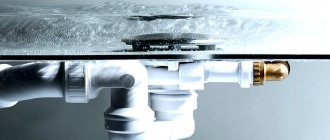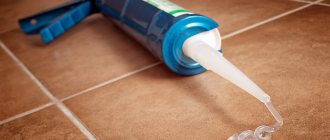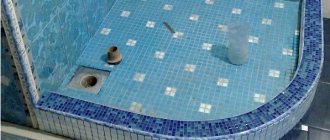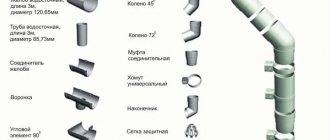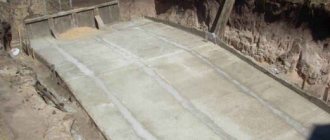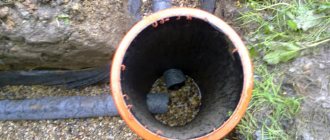SHARE ON SOCIAL NETWORKS
FacebookTwitterOkGoogle+PinterestVk
The siphon is an intermediate link between the shower tray and the sewage system. It not only removes waste water from the plumbing fixture, but also acts as a hydraulic seal, preventing the penetration of unpleasant odors from the sewer network into the room. In order to choose the right siphon for a shower stall with a low tray, you should study the types of products and their technical characteristics.
Modern models of siphons for shower cabins can decorate the bathroom
Why do you need a siphon: product design
Before considering the shutter device, you should understand the question of why a siphon is needed. This element of drainage fittings is installed on all plumbing fixtures. The product is multifunctional. The main purpose of the siphon is to ensure unhindered drainage of wastewater from the plumbing fixture into the sewer network.
The siphon for low trays has a special shape and dimensions
The siphon design includes a water seal that prevents musty odors from entering the bathroom from the sewer system. The gate also collects debris that ends up in wastewater. Siphons are presented in a wide variety of types, but all products have a universal design. The distinctive difference is only in the geometry, dimensions and material of manufacture of the component elements.
As can be seen in numerous photos, the siphon consists of the following elements:
- frame;
- drain grate;
- sealing rubber bands;
- a pipe for connecting the valve to the waste pipe, which can be straight or angled;
- glass of water seal;
- water seal;
- plastic or cardboard safety valve;
- self-sealing gasket, which fits onto the outlet pipe on the body;
- washer and nut.
The body of the siphon for the shower tray is mainly made of plastic. There is a filling inside it. It is attached to the tray using stainless steel pins. The drain grid is attached to the upper part of the water seal glass using special hooks, which prevents its spontaneous displacement. It is made of stainless alloys. To ensure sealing of the connections between the tray and the body, and the tray and the grill, sealing rubber bands are installed.
Installation dimensions of a siphon for a shower cabin
Helpful advice! More reliable sealing is provided by ribbed gaskets, which have a positive effect on the durability of the siphon, since they require the use of little force when assembling structural elements.
Exploitation
Sink valves are easy to operate. Care consists of control and timely cleaning (if necessary). To clean the shutter device, remove the grate, remove the water seal from the glass, and remove deposits. In general, mechanical cleaning is rarely resorted to. To make siphons less likely to become clogged, experts recommend cleaning the sealing product once every six months as a preventative measure. This is done using household chemicals suitable for plastic structures.
If a blockage occurs, air purging of the hydraulic seal under high pressure is unacceptable. It can lead to rupture of parts of the structure. It is also unacceptable to try to remove debris with sharp objects, as this can damage the walls of the corrugated pipe or other parts of the valve structure.
Types of drains for showers
Based on the design, there are the following types of siphons:
- bottled;
- corrugated;
- pipe;
- dry.
Bottle siphons look like a flask or bottle, where the upper part is connected to the drain in the pan, and the lower part is connected to the waste pipe. A design feature is the elevation of the outlet pipe above the inlet pipe, thereby forming a water seal. At the bottom of the bottle, debris settles and accumulates, which does not enter the sewer network, but is removed periodically mechanically by unscrewing and washing the bottom of the product.
Bottle siphons come in two types: with one pipe that is immersed in water, and with two communicating chambers that are separated by a partition. The main advantages of such valves are simplicity of design, durability, and easy cleaning from dirt.
Low shower tray with installed drain seal
Note! Such siphons are intended for shower cabins with a high tray or low appliances located on special podiums.
Corrugated siphons are very popular. Their main advantage is the elasticity and flexibility of the design. Thanks to this, the corrugation for a shower cabin can be given any shape, which makes the product universal and suitable for all shower cabins. This product is easy and quick to install. Another advantage is the low price of a siphon for a shower stall.
The main disadvantage is the small wall thickness, which reduces its durability. At the time of installation, the product is given a U- or S-shape. This contributes to the development of significant tension, which will lead to rapid damage to the integrity of the body. Corrugated siphons require frequent preventive cleaning, which is caused by the design feature of the product. Its inner surface consists of a large number of folds in which contaminants that come with wastewater accumulate.
Important! The bend of the corrugated siphon must be made in such a way that the water completely covers the pipe opening.
Corrugated siphon for shower cabin
Characteristics of pipe and dry valves
Pipe siphons have a U- or S-shape. The design is made of hard plastic. A water plug forms at the bend of the pipe. The smooth internal surface of the products eliminates the accumulation of deposits on the walls of the valve, which are discharged directly into the drain. These siphons are small in size, making them ideal for low pallets.
A relatively new version of the shut-off product is a siphon for a shower tray with a dry seal, which ensures complete drainage of waste water without retaining it in the body of the device. The role of the water lock is played by a silicone membrane, which is made in the form of a polymer tube. Under the influence of water pressure, it expands, allowing flow to pass through, and returns to its original position in the absence of drainage. This design eliminates the possibility of spontaneous reverse flow of water into the plumbing fixture in the event of a clogged sewer line.
The dry shutter is compact, which allows it to be used under the lowest pallets. This feature saves space and greatly simplifies installation of the product. This is the most relevant option when arranging a drain for a shower stall without a tray.
The dry shutter is characterized by durability and reliability, resistance to temperature changes. This seal does not dry out or freeze, so it can be used in any room, including those that have constant heating. This is an ideal option for baths and saunas, when there is no need to preserve the valve product during low temperatures. Due to the absence of a large number of parts and bends in the design, such a valve is not prone to the accumulation of dirt in the internal cavity, which greatly simplifies its operation and eliminates the need for frequent inspections. The disadvantage of a dry siphon is its high cost.
Flat siphon for tray with dry seal
Note! A dry seal functions normally in proximity to a heated floor, which is capable of drying out all the moisture from traditional siphons with a water seal, thereby having a negative impact on the normal operation of the device.
There are also siphons with overflow, which are additionally equipped with a connecting pipe. This type of shut-off valve is used if there is an overflow in the pallet design. These siphons are most often of the corrugated type, which allows you to change the position of the overflow depending on the type of shower stall.
Exploitation
Sink valves are easy to operate. Care consists of control and timely cleaning (if necessary). To clean the shutter device, remove the grate, remove the water seal from the glass, and remove deposits. In general, mechanical cleaning is rarely resorted to. To make siphons less likely to become clogged, experts recommend cleaning the sealing product once every six months as a preventative measure. This is done using household chemicals suitable for plastic structures.
If a blockage occurs, air purging of the hydraulic seal under high pressure is unacceptable. It can lead to rupture of parts of the structure. It is also unacceptable to try to remove debris with sharp objects, as this can damage the walls of the corrugated pipe or other parts of the valve structure.
Classification of siphons for shower trays according to the method of closing the drain
The shower tray can be used not only for its intended purpose. It can become a bath for a small child, or a container for soaking laundry. In these cases, it is necessary to ensure that some amount of water is retained. To achieve this, there are several options for closing the shower tray drain.
The easiest way to control the drain is to use a plug to close the outlet. This option is used for siphons that are not equipped with special shut-off valves, which are becoming increasingly rare in modern shower stalls.
Siphon for shower tray with CLICK-CLACK system
An improved drain locking system is an outlet with an automatic bottom valve, which closes the hole by acting on a lever that is connected to the valve. It is located near the mixer and is purchased along with it, which facilitates the operation of the water outlet, eliminating the need to come into contact with contaminated water, bend over or perform other manipulations.
The third option for controlling the drain is the click-clack button, which is included with the shut-off valves. Pressing it once with your foot will completely block the drain hole. Repeated exposure will allow water to flow freely into the sewer system. A siphon in a shower stall with a click-clack button is the most reliable, convenient to use, easy to install and durable option. In addition, such a water outlet system is characterized by an attractive design. The disadvantage of this option is the high cost of the product.
Rectangular designs
Despite the similarities in the installation rules for all types of cabins, a rectangular shower has its own installation algorithm: first of all, the back panel with the equipment is attached. After that are the side walls. Lastly, the front part with the doors is attached.
Other features:
- Such a shower does not always require a tray. The drain can be installed directly into the floor, providing an inclination angle of 2 degrees. For an impressive appearance, the floor with a built-in drain is decorated with tiles (using a level at each step so as not to change the angle of inclination). It is allowed to use a special drain snake (drainage) around the perimeter of the cabin instead of a standard siphon.
- The faucet and shower pipe are not mounted on the roof or side panel, but directly into the wall.
- Instead of a metal profile, hinges can be used to fix the walls.
How to choose the right siphon for a shower cabin with a low tray
When choosing a siphon for a shower stall, you should focus not only on the design and operating principle of the device. The decisive factors are geometric dimensions, throughput, productivity, installation complexity and durability of the device. The installation height of the siphon is selected based on the design features and installation option of the shower tray. For plumbing fixtures that are located at some elevation, the size range of valves increases.
Modern drain holes have a neat and stylish look
The height of the siphon varies between 8-20 cm. The diameter of the shutter can be 52, 62 and 90 mm. It is selected based on the size of the outlet hole in the pan, which it must match. You should not select a siphon with a diameter of 52 mm for a large hole. Despite the fact that during installation it will be necessary to use additional measures to seal the connection, it will not be characterized by increased reliability and durability. Also, the size of the siphon should not exceed the diameter of the waste pipe. In this case, it will not be possible to achieve the required throughput of the valve, which will cause some inconvenience and the need to constantly monitor the water level in the pan.
Note! Drain pipes with a diameter of 52 and 62 mm ensure normal drainage of water from the pan, the level of which does not exceed 12 cm. For greater depths, a water outlet with a diameter of 90 mm is used.
An important technical characteristic of a siphon is its throughput, which determines the amount of water flowing into the sewer per unit of time. The average value is 30 l/min. The throughput directly depends on how the shower stall works, and is often indicated in the instructions for the device.
Note! To ensure stable flow of wastewater and avoid flooding of the pan, it is necessary to use drainage fittings with appropriate capacity. The latter is selected based on the performance of the mixer.
The average throughput of siphons is 30 liters of water per minute
Useful tips when choosing a shower drain
When choosing a drain for a shower tray, you should pay attention to the decorative grille. The best option is a product made of stainless steel. If other alloys were used to create it, you should choose models with double chrome plating, which is resistant to mechanical damage and the effects of various chemicals. You should not purchase nickel-plated plastic products, whose decorative coating will quickly wear off.
When choosing a siphon, an important point is the ease of cleaning the product from blockages. This is especially true for low trays without an overflow system. The best in this case are self-cleaning models, which are distinguished by their special shapes and the presence of bends in the structure, which eliminates the possibility of dirt accumulating inside the product. Gates with a mesh to retain small debris are also distinguished by their stable operation. And siphons equipped with a control hole will allow you not to think about the question of how to clean the shower drain.
Before purchasing a shutter, you should also pay attention to the quality of the material. The drainage fittings are located under the pan and therefore experience minimal loads. Products fail as a result of the natural aging of plastic. Siphons made of high-quality plastic are characterized by strong intermolecular bonds, while low-quality cheap products are characterized by fragility and fragility. The length of the product's service life is also influenced by the number of components. The more there are, the lower the reliability of the device. Drain fittings must be easily and quickly disassembled and assembled by hand. Installation of the device must be carried out using a minimum set of tools.
Easy disassembly of the design will facilitate subsequent care and cleaning of the product
In conclusion
Installing a shower stall in your home is not a difficult task. Particular attention should be paid to connecting the pan to the sewer; communications will be hidden, so it is better to do everything correctly right away than to correct minor defects later. The proposed material will allow you to correctly connect the pan to the sewer.
Sources:
- https://sovet-ingenera.com/santeh/vanna/sliv-dlya-dushevoj-kabiny.html
- https://stroyday.ru/remont-kvartiry/ustanovka-i-remont-santexniki/sliv-dlya-dushevoj-kabiny.html
- https://stroy-podskazka.ru/vannaya/dushevye-kabiny/sliv/
- https://stroitelniportal.ru/stati/santehnika/vybor-i-montazh-sliva-dlya-dushevogo-poddona-svoimi-rukami/
- https://gidroguru.com/vnutrennyaya-kanal/razvodka/dush-kabiny/2557-sliv-dlya-dushevoj-kabiny
- 1
Which siphon is best for a shower stall: a review of popular models
One of the best models is a siphon for shower trays TECE from a German manufacturer, which provides a 10-year guarantee on the product. The height of the shutter is 6-9.5 cm. The throughput of the siphon does not exceed 42 l/min.
The siphon for the shower cabin with a Viega water seal, made of high-strength plastic, is also of good quality. The decorative grille is made of alloy steel sheet. The valve has a flow rate of 38.4 l/min.
A good option is the Swiss Geberit siphon with a warranty period of 10 years. The shutter is made of modified plastic. The siphon is height adjustable. The diameter of the product is 5-6 cm.
Related article:
Water seal for sewerage: an important element of plumbing equipment
Device characteristics. Types of siphons depending on the design. Materials for manufacturing. Siphon installation. Troubleshooting.
A siphon with an AlcaPlast water seal from a Czech manufacturer is made of modified plastic. The direction for releasing water can be straight, lateral or sloped. Available in diameter 5-6 cm.
Radaway siphon is available in different diameters. The model is height adjustable up to 2.5 cm. The shutter element has a self-cleaning function, which simplifies its operation.
The Cezares siphon from the Italian company is made of impact-resistant plastic. The height of the shutter is 10 cm. The model is available in diameters of 5, 6 and 9 cm. The shutter for a shower stall with a low tray is equipped with a decorative grille with double chrome plating. The throughput does not exceed 33 l/min. The valve is available with a direct or lateral direction of water drainage.
The Unicorn siphon without a water seal from a domestic manufacturer has a good price-quality ratio. The height of the product is 6.5-8.5 cm. The throughput does not exceed 32 l/min.
Siphon made of modified plastic from Geberit
Material of walls and doors
There is not much choice in cabin wall materials. It is either glass or plastic.
The priority is glass, which can be frosted, transparent or a combination. Also, modern cabin doors can be tinted or any desired color, in accordance with the design of the entire bathroom.
For the shower stall, you can choose translucent matte doors.
Glass walls are installed framed and frameless. The frame is made of steel or aluminum and looks stylish and modern.
The frame shower cabin in gold color looks gorgeous.
Frameless cabins fit perfectly into any bathroom interior. Metal corners look stylish and modern.
Plastic is also not ignored; it gives an aesthetic appearance, transparency and lightness to the structure. In addition, it is easy to use and maintain, relatively inexpensive and durable.
In addition to the walls, if there is space in the bathroom, fences in the form of a niche are also installed, finishing them with tiles or stone. There is also a fence on the floor about 10 cm high from the same material. Such podiums with sides are relevant in the bathrooms of apartment buildings, where such a cabin is installed already during the process of living there. In a private house, fencing may not be required if the floor is sloped for such purposes.
A good solution would be to make a small side.
As for the doors, they are installed from the same material as the shower walls - glass or plastic.
Types of doors:
- Glass blocks. Allows you to separate the space of the shower stall in the bathroom.
- PVC curtains. The advantage of them is that they are relatively inexpensive and can be changed periodically depending on wear or mood. They are quite dense and do not allow water to pass through. The average size of such a curtain is 90*90 cm.
If there are no fences, you can put a special circular frame and hang a curtain on it; during the procedures, everything is tightly covered with it, and after that it simply moves, leaving one pallet.
An economical and unusual solution is a circular curtain.
There are options without fences at all, but the downside is that during the washing process the entire bathroom will be flooded and everything will be covered in soapy spray.
Sequence of installation of a shower tray
When installing a shower tray, you can use a ready-made container or mount a structure in the form of a podium made of concrete, lined with tiles. The first option is more popular because it is less labor-intensive. To arrange the podium, you should first study the question of how to make a shower tray, information about which can be found on the Internet.
The place for installing the pallet must be completely clear of construction debris and dust. The bottom row of wall tiles is laid after installing the shower drain. The area of the wall near the pallet and 10-15 cm above it should be covered with a layer of waterproofing mixture, using a roller or brush. The number of layers is determined by the condition of the surface, but there must be at least two.
The legs are attached to the low pallet. To do this, it should be turned over and placed on cardboard to avoid scratches. The legs are fixed using self-tapping screws of the required length, which are included with the pallet. They are designed according to the margin of safety and reliability for a given design, so there is no need to replace them with more durable products.
Important! The legs should be positioned so that they do not come into contact with the sewer pipe.
Shower tray installation process
The pallet is installed in the prepared place. Next, its position is adjusted by turning special screws on the legs. The accuracy of installation is checked using a building level in two directions: along and across the pallet. Upon completion of the adjustment, the locknuts should be tightened to prevent the threaded connection from unscrewing spontaneously.
Next, you need to insert a pencil into the drain hole and draw a circle on the floor. Lines are drawn along the bottom edge of the shelves. The pallet is removed to another place. Using a ruler, you need to clearly mark the lines for the side supporting elements. Next you need to mark the location of the dowels. To do this, you should attach fixing elements to the markings, the upper part of which should be strictly along the line.
According to the markings, holes are drilled for dowels with a depth of 1-2 cm greater than the length of the plastic nozzles. Next, the structure is fastened. A waterproofing strip is fixed to two adjacent sides of the pallet using double-sided tape.
Installation of a siphon when installing a shower tray
The siphon elements should be removed from the packaging. If you are installing the device for the first time, it is recommended to study the instructions in detail and pre-assemble the product.
You can install a siphon for a shower cabin yourself
Place a nut and a rubber seal on the connection pipe between the valve and the waste pipe. The assembled unit is inserted into the outlet on the body, followed by tightening the nut. To avoid damaging the rubber seal, it is recommended to lubricate it with soapy water or technical oil.
Next, the siphon is installed in the place marked on the floor. The pipe that will be connected to the sewer network is measured. If the plastic pipe and pipe will be located at an angle, you should use an elbow that is fixed in the direction of the sewer outlet. To ensure the tightness and reliability of all connections, rubber seals are used.
Important! The slope of the drain pipe must be at least 2 cm per 1 linear meter.
The next step is to install the pallet, which should fit snugly against the wall and be stable on the floor. Its lower side is fixed to the terminals on the walls. Then a rubber gasket is placed on the siphon body. A layer of sealant should be applied to its surface. The body of the device is pressed against the bottom of the tray with one hand. A metal ring is placed on top and secured with bolts. They should be clamped alternately to avoid distortions.
Next, the siphon elbow is mounted in the direction of the entrance to the sewer. The shower cabin is connected to the sewer through a corrugated pipe. If necessary, appropriate adapters are used. After installing the siphon, the tightness of all connections and the absence of odor from the shower cabin are checked. To do this, water is poured into the drain. The final stage is the installation of a decorative drain grate.
Installing a water seal for a shower drain
Required Tools
When installing and connecting a shower cabin to the sewer, you will need certain tools and consumables. The base is made by pouring a concrete screed, which means you should prepare a tool for preparing the solution, carrying out concrete work and applying waterproofing:
- construction mixer;
- shovel;
- measuring container;
- Master OK;
- grater;
- grater;
- putty knife;
- knife;
- scissors.
Tools for concrete screed
The cabin is connected using:
- Bulgarians;
- electric drills;
- hammer drill;
- screwdriver;
- grinding machine;
- hacksaws for metal;
- pipe bending device;
- screwdrivers;
- pliers;
- vice;
- wrenches, socket wrenches, plumbing wrenches, adjustable wrenches;
- chisels;
- chisels;
- hammer;
- mallets;
- paint brushes;
- spatula.
Cabin Connection Tools
Supplies you will need:
- polyurethane foam;
- silicone sealant;
- FUM tape;
- cuffs;
- hairpins.
Quality control and the necessary measurements are provided by a building level, tape measure, metal ruler, corner.
Components of a drainage system
The level of convenient and comfortable living in a private home will depend on the quality and reliability of the functioning of this system. This system is as important as, for example, heating or water supply of a private and country house.
Outdoor amenities will not add the necessary comfort and are extremely inconvenient if an elderly person lives in the family. A properly equipped sewage system plays an important role, since everyone strives to surround themselves with at least the minimum level of comfort that all residents of modern apartments have.
Before draining the bathroom floor, you need to understand the main characteristics of this system. This information will be required at the time of installation work.
The device is designed to remove water from a shower or bath directly into the sewer.
To make an outlet, you will need a 50 mm plastic or corrugated pipe, which will ensure optimal removal of used water.
The screed slope is formed using a spatula. The unset mortar is smoothed out using movements from the center to the edge. All contours are indicated using beacons or steel slats. The pitch of the recessed beacons should match the width of the spatula.
